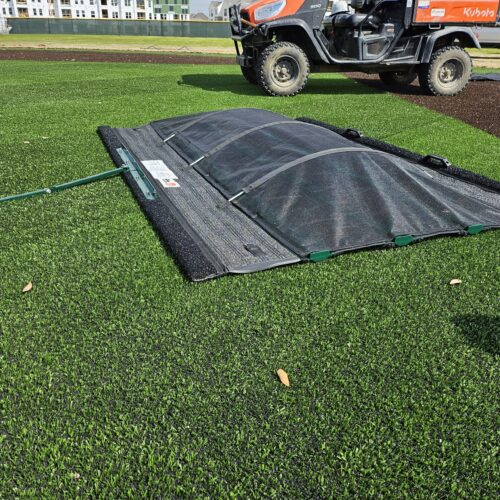As the leaves begin to change and the crisp air signals the return of fall athletics, ensuring that synthetic fields are in optimal condition becomes crucial for the safety and performance of athletes.
Foreign Object Debris (FOD) on sports fields can pose significant safety hazards and impact game quality. Therefore, implementing effective turf cleaning practices is essential to provide a safe playing environment. This article explores best practices to keep playing turfs safe for athletes throughout the season.
Establishing Robust Debris Removal Protocols
Keeping athletic fields clean begins with consistent and reliable systems in place. Schools and universities can safeguard athletes by focusing on three key elements of debris removal protocols.
1. Regular Cleanup Schedules: Keeping Fields Consistently Safe
Sports fields, especially those used frequently by schools and universities, accumulate debris at a rapid pace. Establishing regular cleanup schedules is critical to maintaining safety and ensuring uninterrupted play. High-traffic areas such as team benches, goal lines, and sidelines should be prioritized for more frequent cleaning to minimize risks.
2. Performing Inspections: Identifying Risks Early
Before practices, games, or athletic events, thorough field inspections should be conducted. Walking the field allows staff to identify potential hazards such as loose turf, stones, or broken equipment pieces. These inspections are vital in ensuring issues are addressed before athletes step onto the field.
3. Detailed Checklists: Ensuring Nothing Is Overlooked
To make inspections and cleanups more systematic, detailed checklists can be used. These checklists ensure that no section of the field is missed and that all common forms of debris, such as small stones, plastic, or metallic items, are accounted for and removed promptly.
Using Proper Equipment to Keep Fields Safe
Effective debris management depends on using the right tools for the job. Manual efforts can help, but specialized equipment ensures sports fields are consistently ready for safe play.
While brooms and manual tools may help in minor cleanups, sweepers are the most effective solution for comprehensive debris management. Their ability to cover large areas efficiently makes them ideal for universities and school sports fields.
FOD Control Corporation’s Sportsweeper™, is engineered specifically for synthetic turf. This sweeper is designed to clear debris quickly without causing damage to the playing surface. Its key benefits include:
- Efficiency: Covers large areas in minimal time, reducing labor requirements.
- Safety: Removes both large and small debris, minimizing injury risks for athletes.
- Field Preservation: Maintains turf integrity by providing a thorough yet gentle clean.
Implementing a FOD-Aware Culture
Even with strong protocols and advanced equipment, fostering a sense of shared responsibility ensures long-term success in keeping fields safe.
Educating Athletes and Coaches: Building Awareness
A safe playing environment requires more than tools and protocols, it depends on the people using the field. Educating athletes and coaches about the dangers of foreign object debris (FOD) helps create accountability. Simple habits, such as performing quick “FOD walks” before and after games, can dramatically reduce risks.
Leveraging Signage: Keeping Cleanliness Top-of-Mind
Strategic signage around and outside the field can serve as constant reminders for athletes, staff, and spectators to properly dispose of trash. When all participants are reminded of their role in keeping the field clean, it reinforces a culture of shared responsibility for safety.
Suggested Resources
Check out our articles on Why Summer is Peak FOD Season or Training Airport Ground Crews to Combat FOD for more great ideas.
A Cleaner, Safer Season Ahead
By combining structured debris removal protocols, the use of specialized equipment like the Sportsweeper™, and fostering a FOD-aware culture, schools and universities can ensure safer athletic environments. These practices not only protect athletes from preventable injuries but also preserve the quality and longevity of sports fields for years to come.


